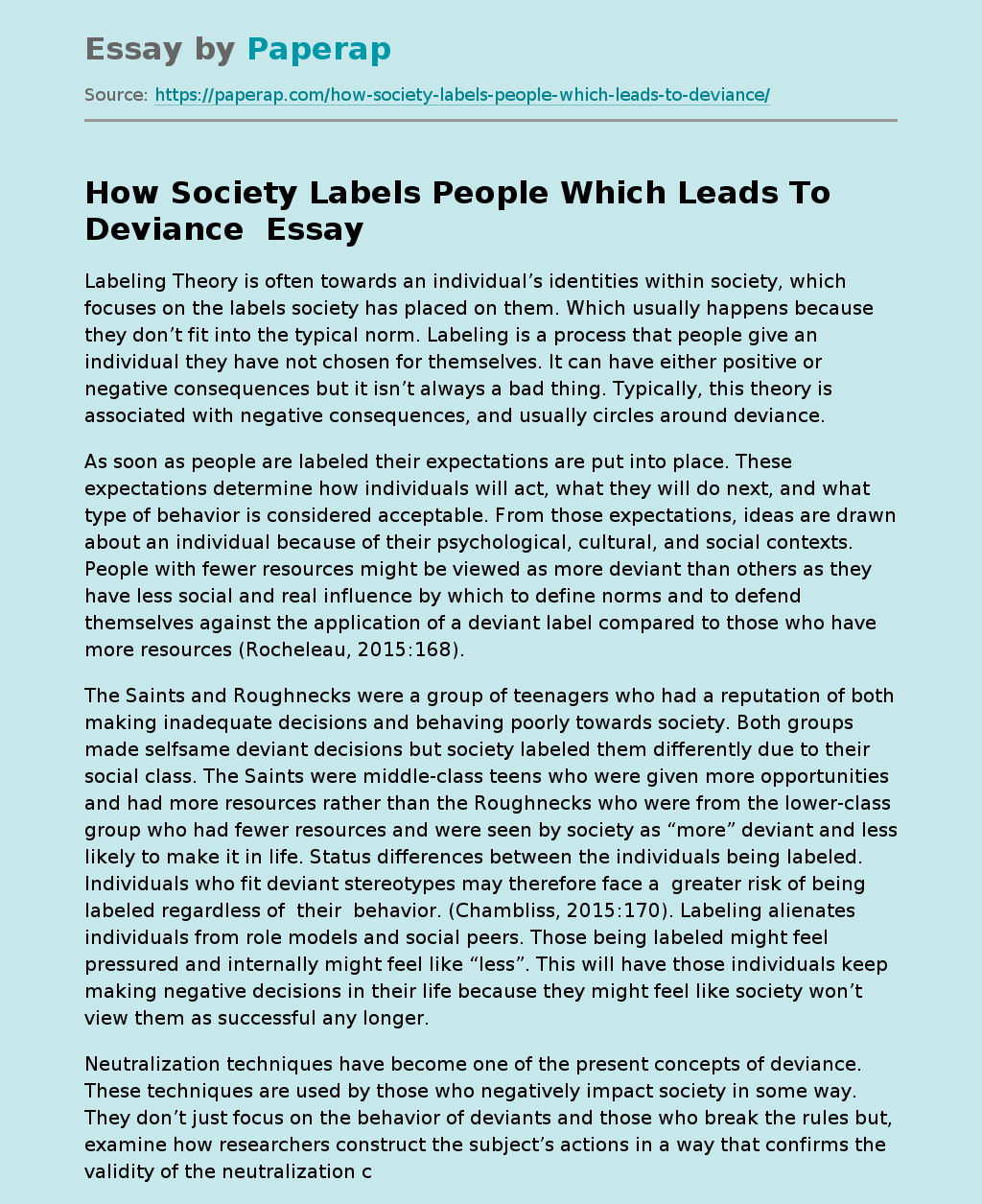How Society Labels People Which Leads To Deviance
Labeling Theory is often towards an individual’s identities within society, which focuses on the labels society has placed on them. Which usually happens because they don’t fit into the typical norm. Labeling is a process that people give an individual they have not chosen for themselves. It can have either positive or negative consequences but it isn’t always a bad thing. Typically, this theory is associated with negative consequences, and usually circles around deviance.
As soon as people are labeled their expectations are put into place.
These expectations determine how individuals will act, what they will do next, and what type of behavior is considered acceptable. From those expectations, ideas are drawn about an individual because of their psychological, cultural, and social contexts. People with fewer resources might be viewed as more deviant than others as they have less social and real influence by which to define norms and to defend themselves against the application of a deviant label compared to those who have more resources (Rocheleau, 2015:168).
The Saints and Roughnecks were a group of teenagers who had a reputation of both making inadequate decisions and behaving poorly towards society. Both groups made selfsame deviant decisions but society labeled them differently due to their social class. The Saints were middle-class teens who were given more opportunities and had more resources rather than the Roughnecks who were from the lower-class group who had fewer resources and were seen by society as “more” deviant and less likely to make it in life.
Status differences between the individuals being labeled. Individuals who fit deviant stereotypes may therefore face a greater risk of being labeled regardless of their behavior. (Chambliss, 2015:170). Labeling alienates individuals from role models and social peers. Those being labeled might feel pressured and internally might feel like “less”. This will have those individuals keep making negative decisions in their life because they might feel like society won’t view them as successful any longer.
Neutralization techniques have become one of the present concepts of deviance. These techniques are used by those who negatively impact society in some way. They don’t just focus on the behavior of deviants and those who break the rules but, examine how researchers construct the subject’s actions in a way that confirms the validity of the neutralization concept (Jacobs, 2005:553). Some neutralization techniques include, “The defense of necessity”, through which the individual reduces his or her guilt by arguing the act was committed achieving a necessary purpose that could not be obtained through conventional means (Christensen, 2007:560). An example for this technique going back with the Saints and Roughnecks would be, “I knew that what I was doing was wrong, but I didn’t have another choice”. Another neutralization technique would be “Appeal to higher loyalties”, through which individuals excused their crime by claiming loyalty to peers and to families. Individuals often believe they must participate in criminal acts to be looked upon favorably by their peer groups (Copes, 2003:112). An example for this technique using the Saints and Roughnecks as an example would be, “I had to do it for my team; if not they would think I’m scared”. These neutralization techniques show how some individuals who act deviant think about the crimes they are committing. They use these techniques and with these techniques we can get an idea of the way they think. We can identify which technique is used and how they come to think about it.
The act of being deviant ties to the sociological perspectives and understandings of patterns of lawbreaking and norm violations. The functionalist perspective believes that deviance plays an important role in society and can be used to challenge people’s views. On the other hand, the conflict theory looks to social and economic factors as the causes of crime and deviance. Unlike functionalists, conflict theorists don’t see these factors as positive functions of society (“Lunem Learning,” n.d.).
Both of these perspectives have approached my topic in a way because they play an important role in connection to deviance. We can compare the functionalist perspective to the Saints and Roughnecks as where the functionalist view for their crimes would be natural. They would view their experiences and conditions as natural outcomes. Their actions and negative decisions will have people thinking about the consequences if they would get if they do the same thing as these groups. The Conflict perspective also ties into the saints and roughnecks in a way that the Saints were viewed as more than the Roughnecks because of the social class. While crime is often associated with the underprivileged, crime committed by the wealthy and powerful remains an under-punished and costly problem with society (“Lunem Learning. “ n.d.). This shows that society looks down on those who are penniless and view them as the cause of being more deviant than those who are wealthy. Labeling causes people to make labels on any person they want because of their economic status, culture, or looks. A person can commit the same crime but what would matter at last would be their social class.
How Society Labels People Which Leads To Deviance . (2021, Dec 07). Retrieved from https://paperap.com/how-society-labels-people-which-leads-to-deviance/

